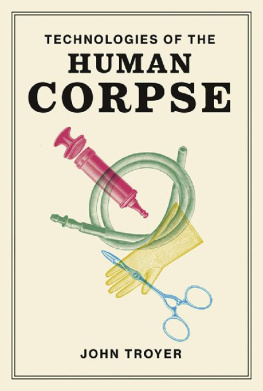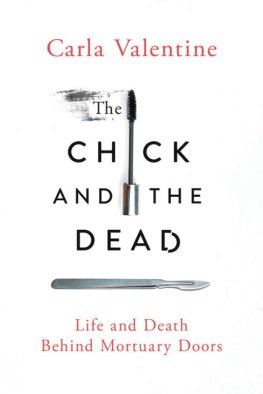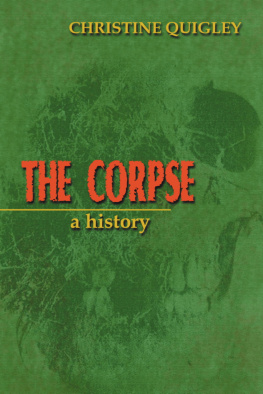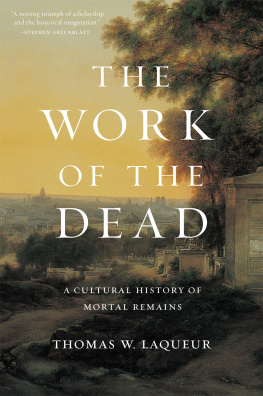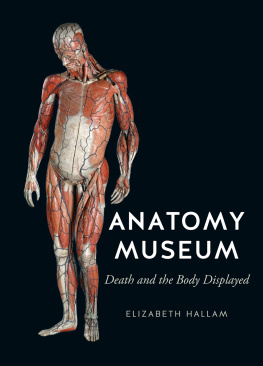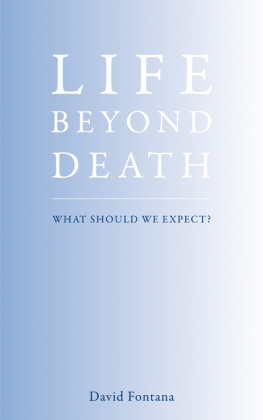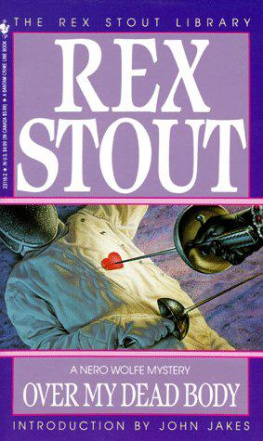
Technologies of the Human Corpse
Technologies of the Human Corpse
John Troyer
The MIT Press
Cambridge, Massachusetts
London, England
2020 Massachusetts Institute of Technology
All rights reserved. No part of this book may be reproduced in any form by any electronic or mechanical means (including photocopying, recording, or information storage and retrieval) without permission in writing from the publisher.
This book was set in ITC Stone Serif Std and ITC Stone Sans Std by Toppan Best-set Premedia Limited.
Library of Congress Cataloging-in-Publication Data
Names: Troyer, John, 1972- author.
Title: Technologies of the human corpse / John Troyer.
Description: Cambridge, Massachusetts : The MIT Press, [2020] | Includes bibliographical references and index.
Identifiers: LCCN 2019028374 | ISBN 9780262043816 (hardcover)
Subjects: MESH: Mortuary Practicehistory | Technologyhistory | Attitude to Death | Funeral Riteshistory | Cadaver | Thanatologyhistory
Classification: LCC RA622 | NLM WA 11.1 | DDC 363.7/5dc23
LC record available at https://lccn.loc.gov/2019028374
10 9 8 7 6 5 4 3 2 1
d_r0
For my younger sister, Julie, and all the times she asked me if I was ever going to finish this book.
And for my parents, Ron and Jean, who also asked me the same question.
Lots of love to all three of you.
Contents
Watching My Sister Die
City of Lakes/City of Death
#21. Julie Post
Fly Faster
#19. Julies Funeral
10 Minutes/10 Days
Gate 11
Airports
Today Is My Birthday
The Last Page
Acknowledgments
The following individuals, groups, and institutions have made the completion of this book possible: first and foremost Gracia Maria Redondo Nevado; my parents, Ron and Jean Troyer; my sister, Julie Troyer; the Department of Social and Policy Sciences and the Centre for Death and Society (CDAS) at the University of Bath; all of my CDAS colleagues, past and present; Matthew Browne and everyone at the MIT Press; Joanna Ebenstein and the Morbid Anatomy Library; Hayley Campbell for intervening when I really needed it; Caitlin Doughty; Phil Olson; Ara Francis; Lyn Lofland; All my Death World friends and colleagues; John Archer; Haidee Wasson; Cesare Casarino; Michal Kobialka; the Department of Cultural Studies and Comparative Literature at the University of Minnesota; Julietta Singh from the Department; all my students in all my classes I have ever taught; Kathie Walczak and the National Funeral Directors Association; Katherine Chew at the University of Minnesota Bio-Medical Library; Michael LuBrant in the University of Minnesota Mortuary Science Program; Taylor & Francis (http//:taylorandfrancis.com) for originally publishing chapter 1 as John Troyer, Embalmed Vision, Mortality 12 no. 1 (2007): 2247, and chapter 3 as John Troyer, Technologies of the HIV/AIDS Corpse, Medical Anthropology 29, no. 2 (2010): 129149; Mary Roach; Candi Cann; Kristi Bakken; Ari Hoptman and Val Pakis for help with my Greek language questions; Amber Tribe; all of my grandparents who died many years before this book came out but who remain at my back at all times; Carol Troyer; Keith Troyer; my amazing and indispensable high school teachers at Hudson High School in Wisconsin; the Chupacabra; and the Bisga Man.
Preface
I needed to finish this book before my entire family died.
While writing, rewriting, and then editing what you are now reading, my younger sister, Julie Troyer, was diagnosed in late July 2017 with an aggressive glioblastoma multiforme brain cancer and underwent emergency surgery to reduce the tumors size. She then received multiple radiation and chemo treatments for the next year before dying on July 29, 2018, in Milan, Italy, where she lived with her family and worked as a schoolteacher. She is survived by her husband and two young children.
In addition to my sisters death, my fathers younger brother Keith died from multiple terminal conditions on June 15, 2018; the same night I received an Alumni Achievement Award from the University of Minnesota for my academic work in the University of Baths Centre for Death and Society on end-of-life issues. Uncle Keith died, by chance, in a University of Minnesota Hospital room two blocks from the awards ceremony. I attended the ceremony with my parents, and we only learned that Keith had died after we left campus and drove thirty-five minutes home to Wisconsin. Following a quick turnaround, we drove back to the hospital and said goodbye.
My father, Ron Troyer, survived a series of heart attacks that started in late 2015 and subsequently required inserting twelve stents into his coronary arteries. As I type these words in early 2019, my parents are preparing to meet with his cardiologist to discuss scheduling open heart surgery, since everyone agrees the less-invasive route is no longer viable. My mother, Jean Troyer, is in relatively good health (thankfully) but does manage some severe arthritis and other age-related conditions.
As for meI should really lose some weight given all the cancer and heart disease raging through my genes (Im working on it). But given all these recent events, the past few years have fundamentally changed how I understand what living and dying mean for my family.
At this point I need to explain that not only am I director of the Centre for Death and Society at the University of Bath, one of the worlds only research centers dedicated to the interdisciplinary study of death, dying, and the dead body, but that my father is also a retired American funeral director. When I say my entire life revolves around death, it is not hyperbole. Death is all I have ever known, and this book is a hybrid response to the death, dying, and dead body constellation that inhabits my life. It started as a mostly academic(ish) text but morphed with time into a book that asks readers to think about death, dying, and dead bodies in radically different ways. This book is also now unintentionally part memoir. I do not consider myself a memoirist, and I do not ever plan to write a memoir, but my sisters death interjected itself into these pages in ways I cannot ignore. I firmly believe that fighting death is a bad idea. Death wins. Death always wins.
Saying Dying
My supposed familiarity with death and dying is why I began this book with my sister; despite my lived experience and academic credentials on human mortality, I was completely unprepared for her untimely death at the age of forty-three.
But I was not unprepared in that way many people are wholly unprepared for a person to die. There was an element of that emotion, but I was raised to understand that any person, especially the people we know and love, unexpectedly die all the time. Death was totally normalized for me in this way. My self-described unpreparedness arrived when at almost every stage of Julies one year living with brain cancer I felt compelled to intervene and ask about hospice care, to make sure that my sister understood she was dying. But for reasons I do not fully understand I did not say anything until the very end.
That is, I finally said something on the night of July 13, 2018, when I was with my sister in Italy and she asked me what was happening, so I told her she was dying. I held her hand and did what none of her medical team had done and said what the counselors kept telling my brother-in-law not to sayI told my kid sister that she was never going home to Wisconsin, that she was going to die in Italy, and that we would do everything we could to make her end of life comfortable. Julie died sixteen days later.
Next page
